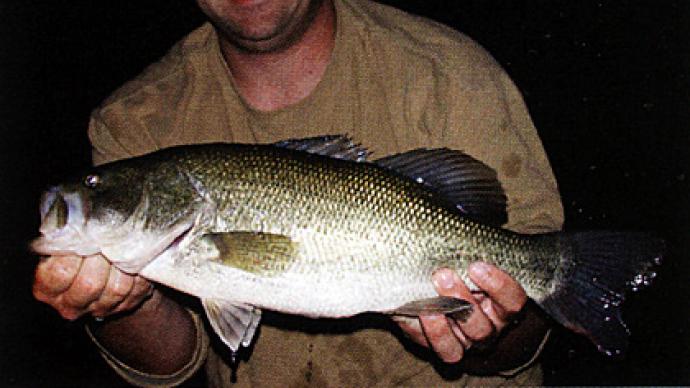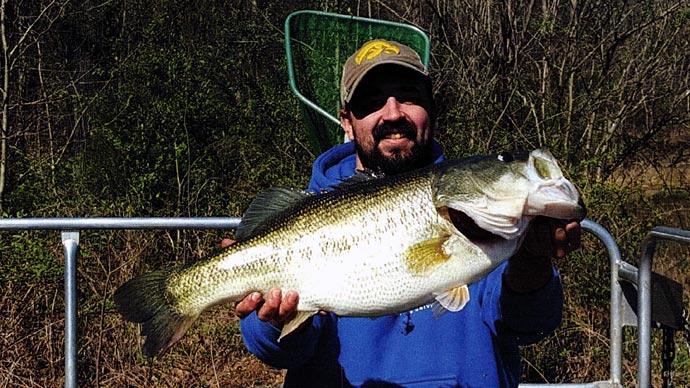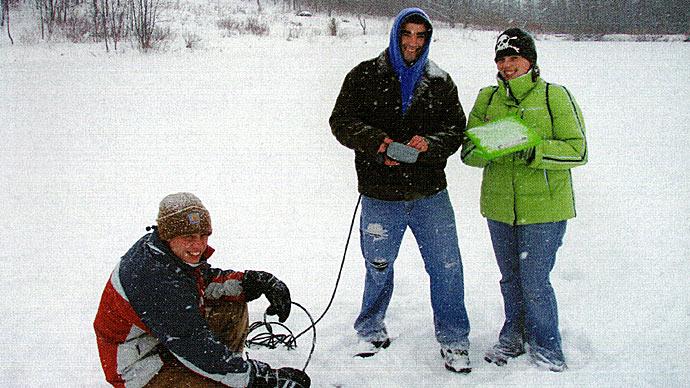
How about some guidance about stocking fish in cooler northern waters?
I remember a consulting trip to upstate New York about fifteen years ago. Knowing very little about cool-water fish, I had the chance to tag along with a college student as he was learning about a lake I'd just taken on with a new client. We'd electrofished the lake several times and caught hundreds of small, cookie-cutter, carbon copy Largemouth bass along with some hefty smallmouths and yellow perch amongst a variety of species. The college kid, recently hired as a guide, tied a small bug on his ultralight spinning rod. In quick succession, he caught two smallies, three yellow perch, and watched as a 30+ inch tiger musky absolved him of the last six inches of his line. I was fascinated. That kid taught me some things about fishing cool waters.
My education about stocking and managing cool-water fisheries was hopping. For two fast-paced years, with each visit lasting anywhere from a week to a month, my learning curve was steep, and fun.
Like we Texans might say, "It ain't the same" as we're used to.
Job One for northern water fish stocking is to learn as much as you can about the different species offish that thrive in those waters.
Job Two is to make sure you have the proper habitat for those fish you want to thrive.
Job Three is to develop a sustainable food chain to support those fish from fry to full-grown adults.
Job Four is to manage your fishery within the bounds of Jobs One through Three.
Before doing anything, however, you need to understand one thing: The information below applies to both new and/or renovated ponds. If you lost fish due to winterkill, don't consider those waters either new or renovated. You need a different protocol for winterkill situations. You'll have homework to do to see what fish are left, and due diligence to prevent future occurrences.
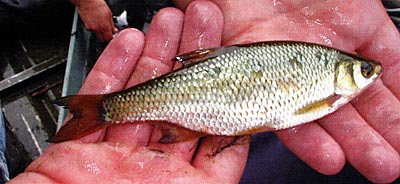
Now, let's start with fish for new or renovated northern waters. A favorite for smaller ponds are smallmouth bass. Smallies can grow fairly quickly, will reproduce in some of the waters, and are huge fun on the business end of a rod and reel. Plus, we love smallies because they don't tend to overpopulate, and they don't overeat their food chains like Largemouth bass ultimately do.
If you want smallies, then start with fathead minnows. They'll jump-start the growth of young smallmouth bass. Plus, all things working normally (whatever that means), fathead minnows can live a couple of years before being munched out of your pond. Fathead minnows lay their eggs on the underneath side of firm objects. Be sure you have that substrate, or you won't have spawning fathead minnows. Think large rocks, bigger pieces of PVC pipe (at least four inches in diameter), wooden pallets, plywood, or Plexiglas. All this spawning substrate needs to be in shallow water, less than two feet deep. Fatheads are so prolific you'll see exponential reproduction without heavy predation.
Another candidate for this project is golden shiners. They're quick, feisty, and tend to prefer deeper waters than fathead minnows. Plus, they'll grow large enough that some of them won't be eaten by smallmouth bass. That provides future broodfish to sustain the species. Several factoids about golden shiners will be helpful, too. They spawn on grass. If you don't have vegetation, break up some bales of straw and spread it around the pond's edge in the early spring. They'll spawn on that. They're nest raiders, too. Shiners are notorious for chasing sunfish off their beds and eating eggs. So, think about the timing of your stocking of golden shiners. Establish your fatheads and sunfish first, and then add the shiners.
Pumpkinseed sunfish are another prime choice with a smallmouth bass fishing pond. They don't tend to overpopulate like bluegills do. That makes them a nice fit with smallies, especially since smallmouth don't tend to overeat their food chain. As a nice plus, pumpkinseeds fill a niche in the littoral zone—that fertile, shallow, vegetated, productive shoreline of a pond. They make a living as a predator, limited by mouth size. But, they also eat crustaceans, especially snails. Snails are the primary hosts for quite a few parasites of gamefish, especially grubs. We like pumpkinseeds for those three key reasons: they're good forage fish for smallies, they eat stuff we don't want, and they are fun on a 5-weight fly rod and popping bug.
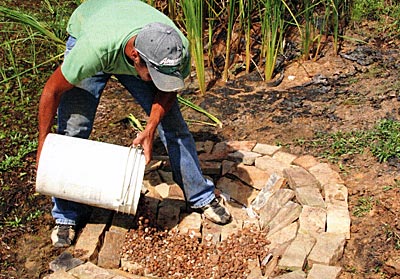
Inevitably, people ask about yellow perch and walleye. Let's tackle walleye, first, since they are pretty simple. Don't expect walleye to reproduce in your pond. Duplicating that habitat isn't practical at all. Look at walleye as a bonus fish— a put and take, value-added critter. But, learn about this species, too. They're toothy, and you know what that means—they'll make a living eating other fish. Walleye don't like warm water, so they tend to stay in deeper areas. As you design your stocking plan, keep that in mind. Odds are low that you'll catch any, and when you do, it might be a couple that weigh a pound, with an occasional five pounder. They'll migrate in and out of deeper water, seeking temperatures they prefer. Look at them as loners or survivors. Speaking of that word, here's a brief description of what you should expect about sourcing these popular northern fish. You can buy fry, barely visible to the naked eye, in May. You might get a bag of them, with a quarter-million fry. will thank you. Everything from backswimmers to scuds feast on those little pepper-flake sized fry. Or, you can tag team a hatchery for what they call pond fingerlings. The difference there is practice. The hatchery times it just right to stock those same fry into perfectly-timed highly fertile waters, teeming with plankton. Walleye fry will be planktivorous for a few short weeks. When they begin that shift from plankton-eaters to carnivores, numbers drop exponentially, because the more aggressive, faster-growing fish will dominate and consume hundreds, if not thousands, of its brethren. Hundreds of thousands of small walleyes soon become only a few hundred if not captured and moved during this critical time period. Meaning? You can get some 1.75-inch walleye in June. If not that, wait until fall and pay big dollars for the remainder of walleye that survived the fish-eat-fish-state and grew to 8-10". The hatchery took those pond fingerlings, moved them into fathead minnow infested, larger waters, doing the best they can to grow walleye as big as they can. Cost for those bigger ones? Think $1-2.00 per inch.
That brings us to yellow perch. Most sportfish-centered biologists have a love-hate relationship with these fish. The love part is they can add healthy diversity to a smallmouth bass fishing pond. But—and that's a big but—if you don't have diverse habitat for yellow perch, don't expect them to grow very large at all. They tend to overpopulate, especially if you aren't a little top-heavy with your apex predator, namely those smallmouths. Perch migrate from shallow to deep, to shallow, depending on water temperatures and food availability. For success, you need bigger waters, several acres or more for these fish to thrive and offer a healthy role in your ecosystem. And, their feeding habits change with seasons, too. For example, biologists commonly report capturing huge yellow perch in deep winter water, gorged with scuds. But, just prior, during, and shortly after springtime, they'll feed heavily on young sunfish—whatever species are available. You've got a catch-22 situation with yellow perch. Don't expect them to grow very large, unless you have enough predators with big enough mouths to keep their numbers in check, and you have a strong, year-round food source for the little golden-jewels. Without that long-term food, they won't grow large. Without plenty of predators, you'll get lots of three-inch perch that serve virtually no purpose other than disrupting what could be a healthy food chain. Bottom line, if you do have different size classes of smallies, with some walleye, you stand a better chance for yellow perch. With diverse habitat in diverse depths, you add to the chances of success with yellow perch. Oh, and you're probably thinking about scuds. My sources suggest either you have them or you don't. They're typically not commercially available, but think about Job One and Two in order to give them a chance at establishing.
See how all this stuff is coming together? Revisit Jobs One through Four and you'll see how your efforts can pay off.
How many of each of these fish should be stocked in the beginning to create a productive fishery? Stock at least ten pounds of fathead minnows in the beginning, preferably shortly after ice-off. Stock more, if your pocketbook doesn't mind. At the same time, stock between 500-1,000 pumpkinseed fingerlings, 1.5-2.5" long. Give those fish some time, at least six months, and it will be even better if you can wait a full year. Then, add your smallies. Stock at least 50 per acre, but not more than 100. Timing helps determine the actual number as well. If you wait a year, stock higher numbers of smallies, and as they grow, watch their relative weights. You'll see when their growth rates begin to level off. That's when you need to think about harvesting some, but harvest is a different story for a different article. Stock 100-200 yellow perch six months after stocking bass, preferably during fall. Add 25-30 advanced walleye about that same time.
Here are a few more tidbits to think about. If you intend some level of management, such as monitoring fertility, supplemental feeding, and aeration, your stocking plan can be altered some. Basically, you can customize the numbers with any or all those influences, with consideration given to the habitat you have under water.
Another tip for northern stocking plans. Avoid Largemouth bass and bluegills. You'll get the polar opposite of what happens in the south. Here's why. Largemouth bass, no matter what, will dominate your fishery. It's not a matter of if as much as when. The downside to bluegills is that with only one or two spawns, they tend to dominate the sunfish population, but the spawn happens so late and bluegills grow so fast, they don't offer much to a forage fish population. Pumpkinseeds are much more mild-mannered, reproductively speaking, in northern waters.
Can you have a fun, successful fishing lake with different species of cool-water fish? Absolutely, you can. Just learn as much as you can about each species, and what they need in order to be successful. Sounds like what we teach our kids, huh? Or, maybe some stuff yours truly learned watching kids a decade and a half ago?
Reprinted with permission from Pond Boss Magazine

